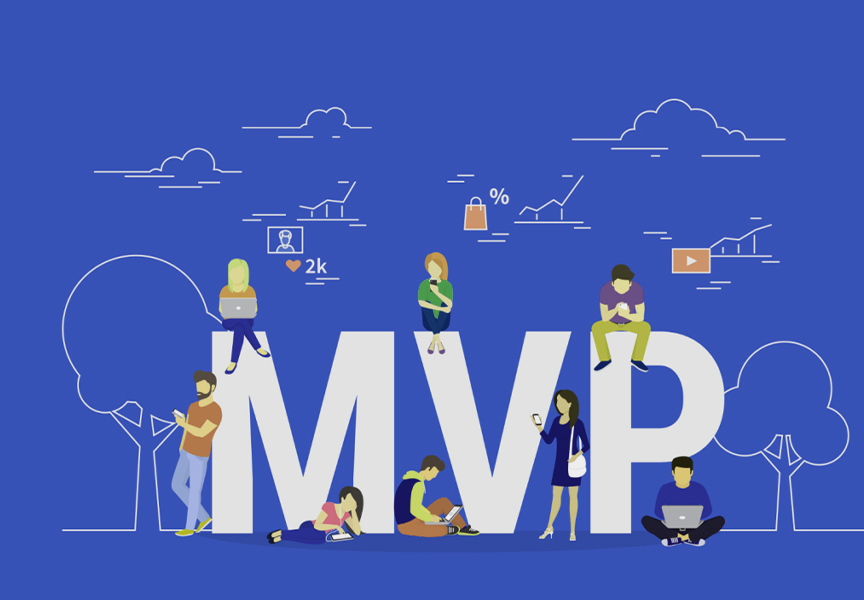MVP Meaning
What does MVP stand for? MVP stands for a minimum viable product. MVP is a version of a product that is sufficient to be released for use, but which only has minimal features. A minimum viable product is usually suitable for early adopters. Once feedback has been gained from these initial users, a full feature set can be developed that will meet wider user needs.
In understanding what an MVP is, there are three main attributes to consider:
- the MVP must present sufficient value that users will try it out
- it should show sufficient benefit that these early users will be retained
- and it should provide feedback opportunities for the development of the product
Critically, the minimum viable product must be exactly that – viable and offering some use to the target market. If it is useless it will turn off customers immediately.
Purpose of an MVP.
There are a large number of reasons why organizations may decide to release and MVP.
The key purposes of MVP in business are as follows:
- Test if it offers value. MVPs allow product developers to see if customers will find a product valuable or useful, without spending a lot to do so.
- Avoid mistakes. An MVP provides the chance to test the market and see what customers are interested in. Understanding this helps the firm avoid going in the wrong direction and making expensive mistakes.
- Gaining customers. Companies that have an MVP can gain customers and income, while those that focus on developing and delivering a more finished end product do not.
- Gain insight about users. Through releasing an MVP it is possible to gain insight about what users like and use and what they do not. This saves time on developing further in areas of disinterest.
- Fastest to market. An MVP can get to market very quickly and start to build up a brand reputation due to first mover advantage.
- Attract funding. If investors see the value in the MVP then this can serve the purpose of attracting investment to facilitate further development.
MVP vs. POC vs. Prototype
It can be confusing to know the difference between an MVP compared with a proof of concept (PoC) or a Prototype.
The main differences are shown in the table below which helps understand how by definition they are different:
| Considerations |
Minimum Viable Product |
Proof of Concept |
Prototype |
| What is the purpose of the development? |
To find out where the product adds value and what its core features are |
To decide if the idea will be feasible as a product |
To examine how the product will work in greater depth. |
| Does the strategy provide the company with customers? |
If the MVP is well thought out, customers can be attracted from launch |
Proof of concepts are usually not offered up to customers to use |
Prototypes are usually not launched for customers to use |
| What are some of the main benefits that come from the strategy? |
Making money from day one and achieving customer retention. Understanding the market |
Attracting seed-stage funding. Seeing if the idea will work technically. |
Seeing how the product might look and feel. Visualizing how it might function |
| Is it used internally or externally? |
The product is used externally with actual customers and feedback can be gained from them |
Tends to only be used internally or sometimes with investors |
Tends to only be used internally |
| Does it function for customers? |
The MVP is a fully functioning working product which has the most critical features operating |
No |
No |
Minimum Viable Product Examples
Examples of successful and unsuccessful MVPs help to better understand the concept and how to do it well.
Examples of successful MVPs
Airbnb
Airbnb is a very famous example of an MVP. The company founders believed they were onto a good idea but needed to be sure it would work before investing money they did not have into it and failing. To test this out they rented out their own apartment, developing a basic website to showcase the flat and found they were quickly able to rent it out, proving their hypothesis. This helped them further develop their MVP software.
Facebook
Facebook is another very well-known example of an MVP. Initially, the development team produced a simple product that allowed people to connect with others at their university. Once it was proven that it was of value to users the company began iterating development to shape it based on feedback gained.
Virgin Airlines
MVPs are not just for software and app development. They are used in other product development too. Virgin Airlines started out by operating just one flight route internationally between London Gatwick and Newark in New York. From this MVP product, interest was proven and the product was refined, leading to expansion into further routes.
Examples of MVP failures
MVP failures do occur quite commonly when insufficient time or effort are put into this.
Here are some high-profile MVP failures:
Electroloom
Electroloom offered users the chance to manufacture clothes using a 3D printer which was controlled via a desktop device. On failing, one of the founders announced that the MVP was not well developed. This combined with not effectively pinpointing a market opportunity led to the company’s failure.
Quibi
Quibi was described as a “Netflix for the phone”. Customers would have access to video content with short episodes (10-15 minutes long). The idea was that other streaming services were not suited to phone users but this would be. One of the main reasons for the failure of this product was there was no trial with an MVP to see what customers actually wanted and if the target market would use the product. Operating an MVP startup would have been more effective here.
Standout Jobs
Standout Jobs did not have a viable proposition in the first place. The founders did not have a sufficient understanding of the market but they set about building a full-feature product before validating the market. Ultimately no one wanted the product, and it failed.
What Makes a Good MVP?
To develop a good MVP it is useful to understand what makes a good MVP in the first place! Here are some characteristics to focus on:
- It works. The MVP must be fit for purpose. If it does not work then users will fail to see the value and will not use it or buy it.
- It has a use. It has a use that people will spend money on or be willing to use it for.
- It is not perfect. The MVP is not a perfectly finished product with all of its final features built in.
- It meets an unmet need. An MVP should meet a need that is not currently met in the market. That might be through offering something that is faster or better in some way, or the product might be completely new.
- It is simple. The MVP should be the most basic possible product that can be delivered that can be used to validate the product in the market.
How do you plan and build a minimum viable product?
Knowing how to go about planning and building a minimum viable product is helpful in driving success.
Here are the steps to take:
- Do your market research. Before starting, look at what is already on the market. Find out what features competitor products have and why customers use them. Look at quality, speed, design and features to gain a deep insight.
- Refine the concept. Based on what has been learned develop a business canvas for your product. This should include key activities, key resources, key partners, customer segments, customer relations, delivery channels, cost structure and revenue streams.
- Decide on priorities. Based on the market research and business canvas define the features that must be in the MVP. These will be “must have” features that make the product usable and that give it value for customers. These features can be included in the MVP and should be the priorities.
- Build. Develop the MVP based on the priorities identified. Do not get tempted to stray into other areas of functionality.
- Release and measure. Once the MVP is ready, release it to the market. Gather metrics on usage and learn from what this is telling you. It should give you an idea of who is interested and why. It should also provide insight into the features that like versus those that are not of interest.
- Refine. From here the product can be adjusted iteratively, continuing the process to ensure a customer focus throughout.
In project management for MVP an agile approach is likely to be best aligned with delivering a suitable solution.
If you’re not sure how to get started, Enkonix can help. We can help you define and refine the concept focusing on the priorities. We can also build your software MVP.
What comes after the Minimum Viable Product?
A minimum viable product is just the first step of an iterative development process. After releasing the MVP and confirming that it is viable the company needs an action plan for undertaking further development. This should focus specifically on the feedback that has been received from customers. The company should review the features that customers liked and those they did not use. This information can be used to develop a list of next-step priorities for product development. The next stage is releasing a version of the product that builds on the first, focused specifically on what the initial users liked and the priority list that has been created. From there, the organization can keep on iterating to shape the product such that it continues to meet customer needs, bring in revenues, and gain a competitive advantage.
The Bottom Line
Developing an MVP makes sense in every way when companies want to validate a concept. Doing so saves time and money that might very well otherwise be wasted building and perfecting a product that no one is interested in. MVP also allows companies to identify the best direction for the product based on the actual use of the MVP by the customers. Feedback directly from customers allows the product to be developed in such a way that is specifically focused on customer needs, rather than on what the business thinks the customer needs. Enkonix can help you not only with the development of MVP, but with the further implementation of the new features. Just contact our representative to discuss the details.
Frequently Asked Questions on Minimum Viable Product
What does MVP mean?
MVP means minimum viable product.
Is MVP a prototype?
MVP is not the same as a prototype. To build an MVP means to launch a simple version of the product to the target market. In contrast, a Prototype is used to visualize how a product will look and work.
Who invented MVP?
The term has been around for quite some time and was first used by Frank Robinson. It has been popularized by Eric Ries who started the Lean Startup movement, and Steve Blank who is an academic and entrepreneur.
What makes a good MVP?
A good MVP is the smallest, simplest product that you can develop which offers value to the customer and helps validate the product.
Why should I use MVP?
MVP is very helpful for validating a concept in the market. Releasing the MVP saves both time and money before investing in a product that customers are not interested in or will not use.
Does the MVP have to work properly?
Yes, it is essential that the MVP works and that customers can see the value in it.
How can I get help with developing an MVP?
As a full-cycle software development company, Enkonix can help. We have helped transform dozens of ideas into digital solutions through programming. We bridge the gap between strategy, design, and engineering. Get in touch to find out how we can help you.
Source: What Is an MVP (And Why Is It Essential)? by Sophie Kleshchuk




